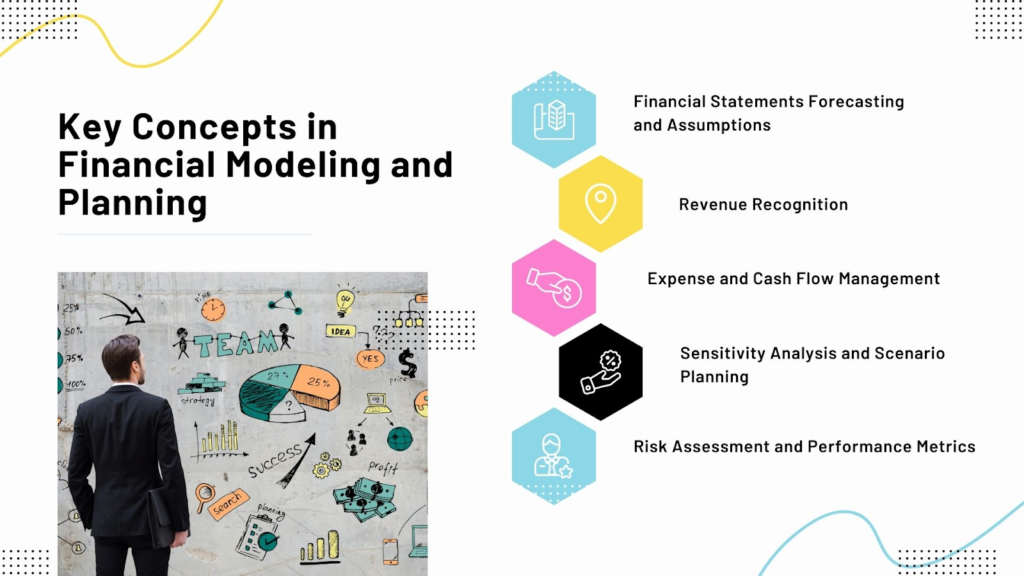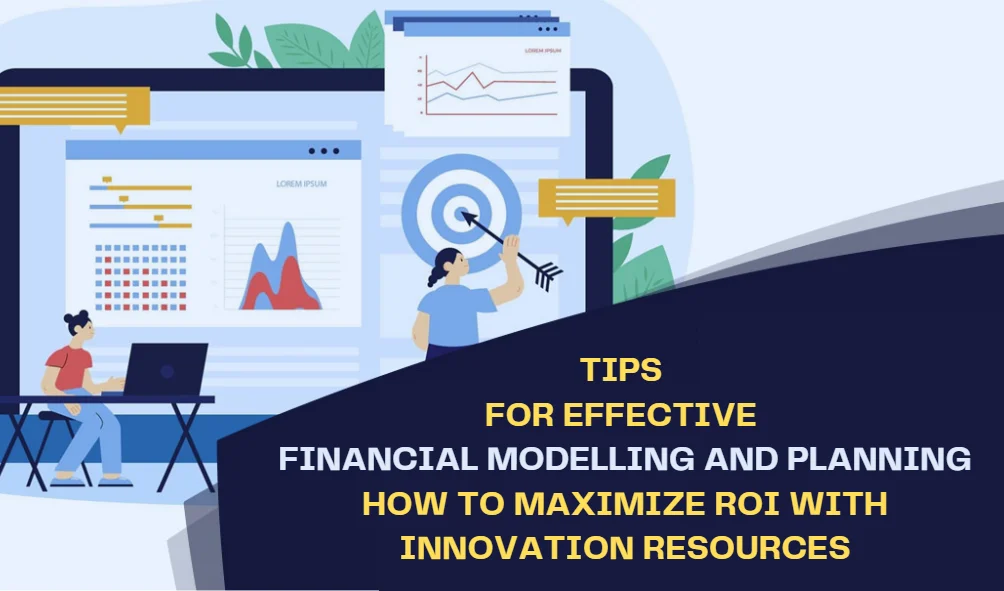As technology and globalization have rapidly advanced over the last decade, companies have had to step up their game to remain competitive. Companies need to be innovative to stay ahead of the curve but where do they turn to maximize the return on their investment? Don’t worry! In this blog, we will provide you with adequate financial modeling and planning tips to help you maximize your return on investment (ROI) with innovation resources.
So, whether you’re a start-up founder or a multinational enterprise, this guide will provide you with tips to help you achieve your business goals.
Financial Modeling and Planning: Key Concepts and Best Practices
Financial Modeling and Planning refers to the process of creating mathematical representations (models) of a company’s financial situation. It includes the utilization of models to make informed decisions and projections about the company’s future financial performance.
It also involves analyzing historical financial data, determining key variables and assumptions, and using various techniques and tools. This helps to create a structured model that reflects the business’s financial operations.
Its purpose is to provide insights into the company’s financial health, assess different scenarios, optimize resource allocation, and guide strategic decision-making. It helps in evaluating the impact of various factors. These factors include revenue growth, capital investment, and market conditions. This evaluation is generally based on the financial outcomes of the organization.
Key Concepts in Financial Modeling and Planning
- Financial Statements Forecasting and Assumptions
- Revenue Recognition
- Expense and Cash Flow Management
- Sensitivity Analysis and Scenario Planning
- Risk Assessment and Performance Metrics

Best Practices in Financial Modeling and Planning
- Start with a clear objective and scope for the financial model.
- Use reliable and up-to-date data to build accurate projections.
- Keep assumptions transparent and document them.
- Regularly review and update the financial mode.
- Implement effective revenue recognition policies based on accounting standards.
- Monitor and manage expenses to ensure they align with the projected budget.
- Pay close attention to cash flow management to maintain sufficient liquidity.
- Conduct sensitivity analysis to understand the impact of changes in key variables on financial outcomes.
- Utilize scenario planning to evaluate different potential outcomes and mitigate risks.
- Develop comprehensive financial statements.
- Assess and mitigate risks associated with the financial model.
- Define and track performance metrics to evaluate the accuracy and effectiveness of the financial model.
Understanding Various Financial Modeling and Planning Tools and Templates
Financial modeling and planning tools and templates are helpful resources that can assist individuals and businesses in managing their finances and making informed decisions. Here are some commonly used tools and templates in a simple and easy-to-understand manner.
Profit and Loss (P&L) Template
A Profit and Loss template, commonly used in Google Sheets. it is a tool to track and analyze the financial performance of a business over a specific period. It helps you understand whether your business is making a profit or incurring a loss. By using the profit and loss template in Google Sheets, users can easily track and assess their company’s profitability, identify areas of improvement, and make informed decisions to optimize financial outcomes.
Cash Flow Statements
Cash flow statements provide a snapshot of your inflows (money coming in) and outflows (money going out) over a specific period. They help you understand how cash moves in and out of your business or personal finances. Cash flow statements typically include sections for operating activities, investing activities, and financing activities.
Break-Even Analysis
A break-even analysis determines the point at which total revenue equals total costs, resulting in neither profit nor loss. This analysis helps you understand how many units or dollars of sales are needed to cover your costs. It can be useful when making decisions about pricing, production volumes, or launching new products/services.
Investment Valuation Models
Investment valuation models help assess the value of an investment opportunity. They take into account factors such as cash flows, discount rates, and growth rates to estimate the present value or future potential value of an investment. These models can aid in evaluating the attractiveness and potential returns of investment options. calculating customer lifetime value
Ratio Analysis
Ratio analysis involves calculating and comparing various financial ratios to evaluate a company’s financial performance and health. These ratios can include liquidity ratios, profitability ratios, debt ratios, and others. Ratio analysis provides a snapshot of a company’s financial position and helps identify areas that may require attention.
Effective Financial Modelling and Planning Tips To Maximize ROI with Innovative Resources
Innovation resources in financial modeling and planning refer to the incorporation of new and advanced tools, technologies, and methodologies to enhance the accuracy, efficiency, and effectiveness of financial modeling and planning processes.
These resources can include state-of-the-art software applications, data analytics platforms, machine learning algorithms, and artificial intelligence techniques. By leveraging innovation resources, financial professionals can automate repetitive tasks, analyze vast amounts of data quickly, and generate more accurate forecasts and projections.
Following are some tips for maximizing ROI with innovative resources:
1. Identify and Assess Innovative Resources
- Conduct thorough research and identify innovative resources that align with your business goals and industry trends.
- Evaluate the potential of each resource by analyzing its relevance, scalability, and potential return on investment (ROI).
- Consider factors such as cost, market demand, competition, and technological advancements.
2. Build a Comprehensive Financial Model
- Develop a robust financial model incorporating innovative resources and their impact on key financial metrics.
- Include detailed revenue projections, cost analysis, cash flow forecasts, and ROI calculations.
- Use reliable financial modeling software or tools to streamline the process and ensure accuracy.
3. Determine Key Performance Indicators (KPIs)
- Define KPIs that align with your business objectives and reflect the impact of innovative resources on financial performance.
- Examples of relevant KPIs would include ROI, net present value (NPV), internal rate of return (IRR), customer acquisition cost (CAC), and customer lifetime value (CLV).
4. Perform Sensitivity Analysis
- Conduct sensitivity analysis to assess the impact of various scenarios and external factors on your financial model.
- Consider different assumptions, such as changes in market conditions, pricing, or adoption rates of innovative resources.
- Identify potential risks and uncertainties and incorporate them into your financial projections.
5. Optimize Resource Allocation
- Allocate resources efficiently by identifying the most promising innovative resources based on their potential ROI.
- Prioritize resources that offer the highest returns while considering the associated costs, risks, and implementation requirements.
- Continuously reassess and reallocate resources based on the performance and feedback of each innovative resource.
6. Monitor and Evaluate Performance
- Regularly monitor and evaluate the performance of innovative resources by comparing actual results to projected outcomes.
- Use financial reporting and analysis tools to track KPIs, identify trends, and measure the effectiveness of your financial model.
- Make data-driven decisions based on the insights gained from performance evaluations.
7. Continuously Adapt and Innovate:
- Foster a culture of continuous learning and innovation within your organization.
- Stay updated on industry trends, emerging technologies, and innovative resources.
- Encourage feedback and collaboration among stakeholders to identify new opportunities and improve existing financial models.
8. Engage Expert Advice:
- Seek the guidance of financial experts, consultants, or industry specialists who can provide insights and expertise in financial modeling and planning.
- Leverage their knowledge and experience to validate assumptions, refine financial models, and maximize ROI with innovative resources.
Remember that effective financial modeling and planning require a combination of strategic thinking, accurate data analysis, and adaptability to changing market conditions.
Conclusion
Incorporating innovative resources into financial modeling and planning is essential to maximize return on investment and stay competitive in the marketplace. Following the steps and tips above can help you effectively manage your finances and make informed business decisions.
Don’t forget to monitor, evaluate, and adapt your financial model regularly to ensure optimum performance and success.


















